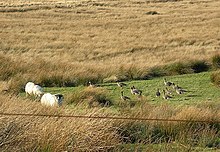Water bird census
Water bird counts are ornithological long-term monitoring of mudflats and water birds .
background
Every year, millions of water birds worldwide move to winter quarters and back again to bridge the cold seasons. They use bodies of water of all types and sizes in Central and Western Europe to rest and eat. Hundreds of thousands of birds also spend the winter on flowing and still waters in Germany between Lake Constance and the Bodden coast.
Water bird counts regularly record the birds and answer questions: How many water birds rest and hibernate in Germany? How are the resting populations developing? Which waters are of international importance as resting areas? With the help of the data, further synecological data and ecosystem questions can be answered.
history
In Europe, the water bird censuses were initiated by ornithological associations.
The international midwinter census, the “International Waterbird Census” (IWC), was initially limited to Europe. The international water bird census was reorganized from the winter of 1966/67. In the meantime, water birds have been recorded in all countries of the Western Palearctic and in around 150 countries worldwide.
Organization in Germany
In Germany, the “Center for Water Bird Research and Wetland Protection in Germany” (ZWFD), an institution within the umbrella association of German Avifaunists (DDA), has taken on the national coordination of the censuses. The ZWFD is in turn supported by
- the Brandenburg "Association for Water Bird Ecology and Wetland Protection" (coordination of the censuses in the eastern federal states)
- the biological station in the Wesel district (coordinates the national geese counts ) and
- the biological station " Rieselfelder Münster " (coordination of water bird counts in the western federal states).
In the "Rieselfeldern" all data are brought together, nationwide evaluations are coordinated and the regular exchange of data with the international umbrella organization " Wetlands International " is guaranteed.
2003 was regularly recorded in 1,200 areas (FALKE 2003).
Counts
Most of the censuses are carried out by volunteer area managers. They are mostly organized in regional or supraregional nature conservation associations ( NABU , BUND etc.). The counts start in the morning and are carried out according to uniform method standards.

